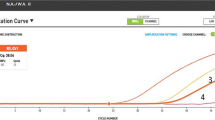Abstract
The interaction of the killer yeast Pichia anomala UP 25F with the killer toxin-sensitive clinical isolate Candida albicans UCSC 10S and its natural toxin-resistant mutant derivative C. albicans UCSC 10R were studied under various conditions. A differential inhibition was shown to occur in vitro at pH and temperature values, which are not encountered in vivo, only by using preformed killer toxin, since antagonism due to yeast growth proved to be predominant on the killer effect. Under adverse growth conditions, the P. anomala killer yeast proved to be able to produce an anatoxin antigenically related to the active or heat inactivated killer toxin. These findings suggest that killer toxins may not function as potential virulence factors in the competition between the opportunistic killer yeast P. anomala and sensitive microorganisms for colonization in the course of natural human infections.
Similar content being viewed by others
References
Polonelli L, Morace G. Reevaluation of the yeast killer phenomenon. J Clin Microbiol 1986; 24: 866–69.
Somers JM, Bevan EA. The inheritance of the killer character in yeast. Genet Res 1969; 13: 71–83.
Tipper DJ, Bostian KA. Double-stranded ribonucleic acid killer systems in yeasts. Microbiol Rev 1984; 48: 125–56.
Bussey H. Effects of yeast killer factor on sensitive cells. Nature New Biol 1972; 235: 73–5.
Hammond JRM, Eckersley KW. Fermentation properties of brewing yeast with killer character. J Inst Brewing 1984; 90: 167–77.
Naumov GI, Tyurina LV, Bur'yan NI, Naumova TI. Wine making, an ecological niche of type K2 killer Saccharomycetes. Biologicheski Nauki 1973; 16: 103–7.
Ganter PF, Starmer WT. Killer factor as a mechanism of interference competition in yeasts associated with cacti. Ecology 1992; 73: 54–67.
Starmer WT, Ganter PF, Aberdeen V, Lachance M-A, Phaff HJ. The ecological role of killer yeasts in natural communities of yeasts. Can J Microbiol 1987; 33: 783–96.
Starmer WT, Ganter PF, Aberdeen V. Geographic distribution and genetics of killer phenotypes for the yeast Pichia kluyveri across the United States. Appl Environ Microbiol 1992; 58: 990–7.
Braude AI, Siemienski JS. The influence of bacteriocins on resistance to infection by Gram-negative bacteria. II. Colicin action, transfer of colicinogeny, and transfer of antibiotic resistance in urinary infections. J Clin Invest 1968; 47: 1763–73.
Chao L, Levin BR. Structured habitats and evolution of anticompetitor toxins in bacteria. Proc Natl Acad Sci USA 1981; 78: 6324–28.
Halbert SP, Sonn C, Swick L. Mixed bacterial infections in relation to antibiotic activities. I. Clostridium septicum-Micrococcus infections. J Immunol 1954; 73: 169–79.
Halbert PS, Locatcher-Khorazo D, Sonn-Kazar C, Swick L. Further studies on the incidence of antibiotic-producing microorganisms of the ocular flora. AMA Arch Ophth 1957; 58: 66–76.
Ikari NS, Kenton DM, Young VM. Interaction in the germfree mouse intestine of colicinogenic and colicin-sensitive microorganisms (33773). Proc Soc Exptl Biol Med 1969; 130: 1280–4.
Ajello L. The medical mycological iceberg. In: Al-Doory Y, ed. The Epidemiology of Human Mycotic Diseases. Springfield: C.C. Thomas, 1975: 290–306.
Dickensheets DL. Hansenula anomala infection. Rev Infect Dis 1989; 11: 507–8.
Drouhet E, Dupont B. Mycoses in AIDS patients. An overview. In: Vanden Bossche H, Mackenzie DWR, Cauwenbergh G, Van Custem J, Drouhet E, Dupont B, eds. Mycoses in AIDS Patients. New York: Plenum Press, 1990: 27–53.
Haron E, Anaissie E, Dumphy F, McCredie K, Fainstein V. Hansenula anomala fungemia. Rev Infect Dis 1988; 10: 1182–6.
Klein AS, Tortora GT, Malowitz R, Greene WH. Hansenula anomala, a new fungal pathogen. Arch Int Med 1988; 148: 1210–3.
Munoz Leoni M-EG, Berenguer J, De Quiros JCL, Bouza C. Catheter-related fungemia by Hansenula anomala. Arch Int Med 1989; 149: 709–13.
Qadri SM, Al-Dayel F, Strampfer MJ, Chuna BA. Urinary tract infection caused by Hansenula anomala. Mycopathologia 1988; 104: 99–101.
Polonelli L, Conti S, Gerloni M, Campani L, Pettoello Mantovani M, Morace G. Production of yeast killer toxin in experimentally infected animals. Mycopathologia 1990; 110: 169–75.
Meers JL. Growth of bacteria in mixed cultures. CRC Crit Rev Microbiol 1973; 2: 139–82.
Morace G, Archibusacci C, Sestito M, Polonelli L. Strain differentiation of pathogenic yeasts by the killer system. Mycopathologia 1984; 84: 81–5.
Polonelli L, Morace G. Production and characterization of yeast killer toxin monoclonal antibodies. J Clin Microbiol 1987; 25: 460–2.
Polonelli L, Conti S, Campani L, Gerloni M, Morace G, Chezzi C. Differential toxinogenesis in the genus Pichia detected by an anti-yeast killer toxin monoclonal antibody. Antonie van Leeuwenhoek 1991; 59: 139–45.
Scherer S, Stevens DA. A Candida albicans dispersed, repeated gene family and its epidemiologic applications. Proc Natl Acad Sci USA 1988; 85: 1452–6.
Sullivan D, Bennett D, Henman M, Harwood P, Flint S, Mulcahy F, Shanley D, Coleman D. Oligonucleotide fingerprinting of isolates of Candida species other than C. albicans and of atypical Candida species from human immunodeficiency virus-positive and AIDS patients. J Clin Microbiol 1993; 31: 2124–33.
Coleman DC, Bennet DE, Sullivan DJ, Gallagher PJ, Henman MC, Shanley DB, Russell RJ. Oral Candida in HIV infection and AIDS: New perspectives/ New approaches. Crit Rev Microbiol 1993; 19: 61–82.
Sullivan DJ, Westerneng TJ, Haynes KA, Bennett DE, Coleman DC. Candida dublinensis sp. nov.: phenotypic and molecular characterization of a novel species associated with oral candidosis in HIV-infected individuals. Microbiology 1995; 141: 1507–21.
Gallagher P, Bennett D, Henman M, Russell R, Flint S, Shanley D, Coleman D. Reduced azole susceptibility of oral isolates of Candida albicans from HIV-positive patients and a derivative exhibiting colony morphology variation. J Gen Microbiol 1992; 138: 1901–11.
Author information
Authors and Affiliations
Rights and permissions
About this article
Cite this article
Conti, S., Cantelli, C., Gerloni, M. et al. Killer factor interference in mixed opportunistic yeast cultures. Mycopathologia 135, 1–8 (1996). https://doi.org/10.1007/BF00436568
Accepted:
Issue Date:
DOI: https://doi.org/10.1007/BF00436568




